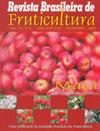Genetic progress in 53 years of the Peach Breeding Program of Embrapa: Fresh market cultivars
IF 0.9
4区 农林科学
Q4 HORTICULTURE
引用次数: 0
Abstract
Abstract A peach breeding program started in 1963, at the Experiment Station of Pelotas, nowadays Embrapa Clima Temperado, whose primary aim was developing cultivars adapted to mild winter conditions. Its first priority was to obtain cultivars of canning type fruits, and over the years, the fresh market cultivars acquired equal importance. This article analyzes the data of 84 fresh market cultivars, obtained in Pelotas, from 1964 to 2017, focusing on the following parameters: time of ripening, fruit development period, average fruit mass, number of fruits per tree, productivity per plant and total soluble solids. First, the data were tabulated, divided into two periods (1964-1984 and 1985-2017), and the descriptive statistical analysis was performed, followed by an analysis via mixed models and estimates of genetic progress via meta-analysis. The main results revealed a reduced fruit development period of the fresh market peaches belonging to that program. It was also observed a significant spread of the time of ripening (end of September or beginning of October until January), with a slight tendency for earliness. Genetic gain was observed for yield corresponding to 1.17 and 2.25% per year, for 1964-1984 and 1985-2017, respectively.桃品种选育53年遗传进展:新鲜市场品种
1963年,在Pelotas试验站(现为Embrapa Clima Temperado)开始了桃子育种计划,其主要目标是培育适应温和冬季条件的品种。它的首要任务是获得罐头型水果品种,多年来,新鲜市场品种获得了同样的重要性。本文分析了1964年至2017年在佩洛塔斯获得的84个新鲜市场品种的数据,重点分析了以下参数:成熟时间、果实发育期、平均果实质量、单株果数、单株生产力和总可溶性固形物。首先,将数据制成表格,分为两个时期(1964-1984年和1985-2017年),进行描述性统计分析,然后通过混合模型进行分析,并通过荟萃分析估计遗传进展。主要结果表明,该方案可缩短鲜市桃的果实发育期。还观察到成熟时间的显著延长(9月底或10月初至1月),有轻微的早熟趋势。1964-1984年和1985-2017年的遗传增益分别为每年1.17%和2.25%。
本文章由计算机程序翻译,如有差异,请以英文原文为准。
求助全文
约1分钟内获得全文
求助全文
来源期刊
CiteScore
1.50
自引率
20.00%
发文量
34
审稿时长
4-8 weeks
期刊介绍:
The Revista Brasileira de Fruticultura (RBF) publishes technical articles and scientific communications in the area of fruit crops, referring to results of original searches and unpublished papers in Portuguese, Spanish or English, and 1 or 2 reviews per edition, of invited authors.

 求助内容:
求助内容: 应助结果提醒方式:
应助结果提醒方式:


